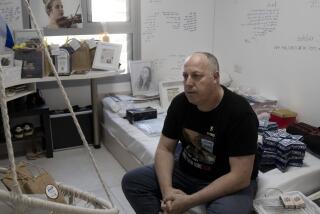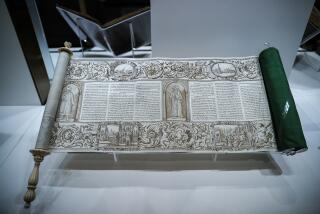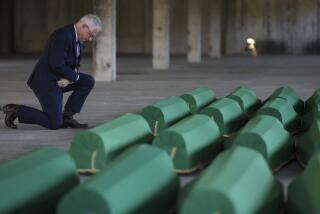Sarajevo Celebrates Passover With Book Saved From Exile, War
- Share via
SARAJEVO, Bosnia-Herzegovina — Bosnia’s Muslim president brought a priceless medieval Passover book to Jewish religious services in Sarajevo on Saturday, dispelling rumors the artifact had been sold to buy weapons.
The book is one of the few cultural treasures to have survived three years of war in a city that enjoyed a prewar reputation for ethnic diversity and tolerance.
The Sarajevo Haggada, as the book is known, was hand-painted and illustrated in northern Spain between 1320 and 1350, and is acclaimed as one of finest illuminated medieval manuscripts in existence.
Bosnian President Alija Izetbegovic joined Jews and the heads of Sarajevo’s Muslim, Orthodox and Catholic faiths, including Cardinal Vinko Puljic, at the city’s only surviving synagogue for Passover services.
“I appeal to you to stay in this country because it is your country too,” Izetbegovic told the Sarajevo Jews as the Haggada was displayed. “Our aim is that this be a country of tolerant nations and religions.”
*
For thousands of years, Jews have marked Passover by recalling their exodus from Egypt with readings from the Haggada--Hebrew for “the telling.”
In 1492, when Jews were expelled from Spain and Portugal, they took the Haggada with them.
The book arrived in Sarajevo with a Sephardic family named Kohen. The Kohens kept the book until the late 19th Century, when they sold it to the National Museum.
Nazi Germany occupied Bosnia in World War II and attempted to confiscate the book in 1941. But it had been removed from the museum by an Islamic scholar and hidden under the floorboards of a peasant hut in the mountains. The book was one of the few Jewish artifacts in Sarajevo to survive World War II.
Bosnian government authorities again spirited the book to safety when fighting broke out in the city in April, 1992.
The Haggada was saved but incendiary shells from separatist Bosnian Serbs who surround the capital destroyed 22,000 manuscripts--some of them 900 years old--in the city’s Oriental Institute in May, 1992.
Serbian shelling also destroyed the National Library and badly damaged the National Museum, along with much of their contents. Orthodox icons, Catholic churches and the slender spires of mosques across the city have all been damaged in the war.
Even the city’s old Jewish cemetery, the second most important in Europe, has been ravaged. Perched on a hillside overlooking the city, the cemetery marks one of the city’s most bitterly contested front lines.
Many of its centuries-old tombs and monuments have been blasted into oblivion by shell fire, and military trenches now snake through the tangled undergrowth of what was once a manicured graveyard.
More to Read
Sign up for Essential California
The most important California stories and recommendations in your inbox every morning.
You may occasionally receive promotional content from the Los Angeles Times.










